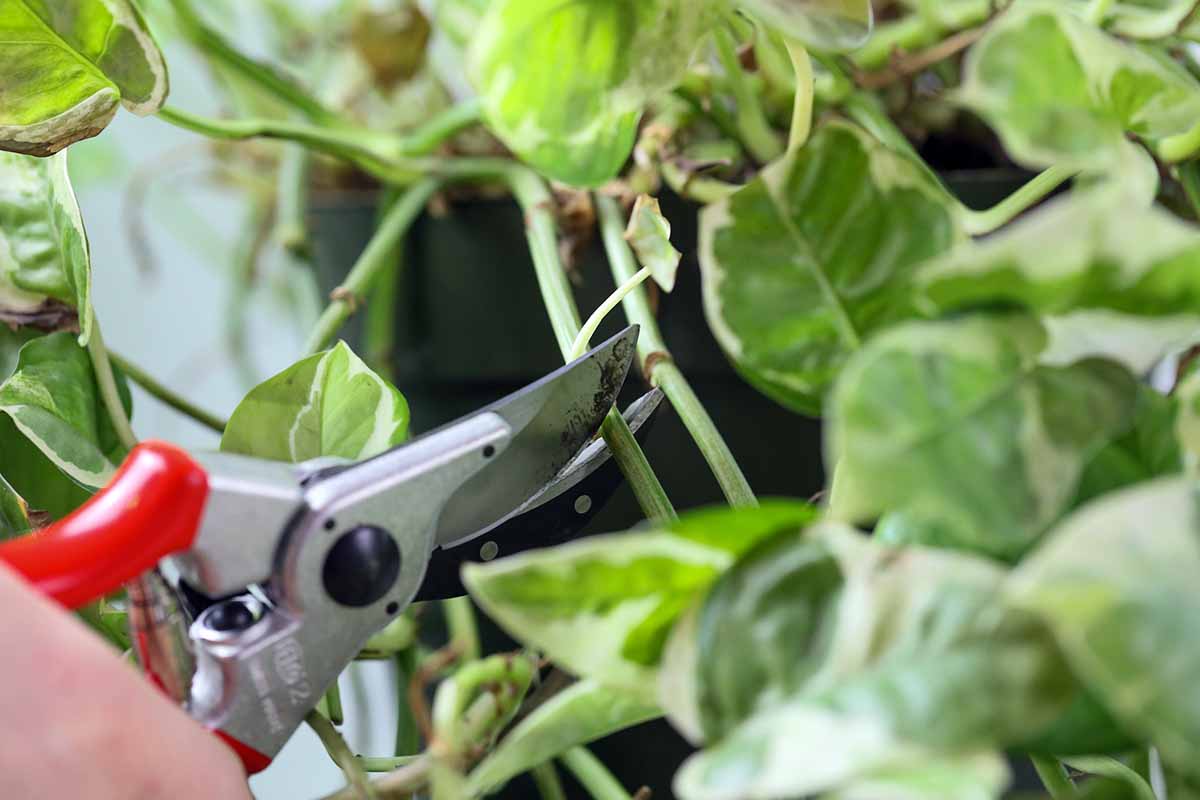Prune your pothos every now and again to tidy up its appearance and stimulate new growth
Pothos plants, also known as devil’s ivy or the Rapunzel plant, are great, low-maintenance plants for beginners. They will be happy on a shelf in a bright, warm place. In fact, they will be so happy that your pothos vines may reach the floor before you know it.
Since this is one of the most common houseplants, you should make sure you know how to properly care for it, including when to prune it.
Pruning is a crucial aspect of maintaining the health and vitality of your pothos plants. You might want to prune your pothos for two main reasons: to make it bushier or to cut down on the very long vines that tend to grow. Either way, the steps are the same and our guide will show you how to do it. ( credit: Jonny Forsey / Alamy Stock Photo).
With its cascading vines and easy-going nature, pothos is one of the most popular houseplants around. But left to its own devices, a pothos plant can become a bit unruly. By learning how to properly prune pothos, you can keep your plant shapely, vibrant, and under control.
Pruning pothos gives you the chance to redirect its growth and promote fuller, bushier foliage Trimming back overlong vines maintains a reasonable size while also generating new growth. It’s an easy process that, done right, leads to a lusher and healthier pothos.
In this article we’ll explore when and how often to prune pothos. We’ll outline what tools to use and where to make cuts. You’ll also learn techniques like pinching and tips for using the trimmings. Let’s get pruning!
Why Prune Your Pothos?
Here are some of the key benefits of occasional pruning for pothos plants:
-
Directs energy to new growth that’s fuller and bushier
-
Maintains a compact, manageable size
-
Removes damaged, diseased, or dead foliage
-
Optimizes light exposure to lower leaves
-
Generates cuttings for propagation
-
Improves both appearance and vigor
Pruning is an act of preventive care for your pothos. Though these plants are forgiving, occasional trimming keeps them looking their best while enhancing health.
When to Prune Pothos Plants
Pothos can be lightly pruned any time of year to remove yellowed leaves, trim dying stems, or pinch back tips. But more extensive pruning is best done in the active growing season.
Spring – As growth picks up in spring, prune pothos to shape the plant and remove any winter damage. The increasing daylight ushers in new vine growth.
Summer – Height of the growing season from late spring to early fall is prime time for pruning. Trim sparingly to avoid shocking the plant.
Fall – Scale back watering and pruning as growth naturally slows from fall into winter dormancy.
Tools and Supplies for Pruning Pothos
Pruning pothos requires just a few simple supplies:
- Clean, sterile pruning shears or scissors
- Small container of isopropyl alcohol
- Water to mist plant after pruning
- Optional: Gardening gloves for protection
The most important tool is a pair of sharp pruning scissors or shears. Clean blades make smooth cuts that heal rapidly. Wipe the blades with isopropyl alcohol before and after pruning to prevent spreading disease. Gardening gloves also safeguard your hands from sticky sap secretions.
How to Prune a Pothos Plant
Ready to trim your pothos? Follow these steps for successful pruning:
Inspect for Damage
Carefully examine the plant and identify any diseased, yellowed, or damaged foliage and stems. Also look for dense areas that could benefit from thinning.
Sterilize Pruning Tools
Wipe down shears or scissors with isopropyl alcohol to sterilize the blades before making cuts. This prevents transmitting diseases between branches.
Remove Unhealthy Growth
Use the shears to cut away any leaves or stems that are yellow, withered, or appear diseased. Removing unhealthy parts redirects energy to the robust foliage.
Trim Overlong Vines
Identify any lengthy vines that are becoming unruly. Trim them back above a leaf node, leaving at least 2-3 nodes. New growth will emerge from nodes below each cut.
Pinch Off Vine Tips
Lightly pinch off the last few inches of stem tips using your thumb and forefinger. No tools needed! This encourages branching from the nodes right below the pinch.
Mist Lightly After Pruning
Misting the leaves after pruning helps reduce transplant shock. Keep the soil moist, but don’t overwater after trimming pothos.
Be selective when pruning – don’t remove more than 20% of the plant. And resist the urge to prune heavily right before winter.
Propagating Pothos from Cuttings
Rather than discarding the trimmings, use them to propagate more pothos plants! Here’s how:
-
Cut a piece below a node, leaving a few leaves at the tip.
-
Place the cutting in a jar of water. Roots will sprout in 4-6 weeks.
-
Once rooted, plant the new start in its own potting mix. Keep soil moist until established.
With proper care, propagated pothos cuttings will grow into full-fledged vines you can use to expand your collection – or give away as gifts!
Troubleshooting Issues After Pruning Pothos
Pothos are generally unfazed by judicious pruning. But improper aftercare can cause issues. Here are some potential problems and solutions:
Drooping leaves – Overwatering after pruning may lead to edema (swelling) or rot. Let soil dry out between waterings.
Leaf yellowing – Insufficient light; move to a brighter location after pruning. Submerging cut ends in water can also cause yellowing.
No new growth – Heavy pruning before dormancy may delay regrowth. Be patient and wait for spring.
Brown leaf tips – Low humidity is likely the culprit. Mist regularly or use a pebble tray for moisture.
Caring for Your Pothos Post-Pruning
After pruning your pothos, implement good care practices to encourage strong regrowth:
-
Ensure adequate bright, indirect light from a south or west window.
-
Water when the top few inches of soil become dry. Avoid oversaturation.
-
Mist regularly to maintain moderate humidity around the plant.
-
Turn the plant periodically to ensure even light exposure on all sides.
-
Apply a balanced liquid fertilizer monthly through the growing season.
-
Monitor new growth and prune again if needed to shape vines.
With the right post-pruning care, your pothos will flourish! It may take a few weeks for new vines to emerge after extensive pruning. But new foliage growth indicates the plant is recovering well.
FAQs About Pruning Pothos Plants
If you’re new to pruning houseplants, you probably still have some questions. Here are answers to some frequently asked questions about trimming pothos vines:
How much can I prune my pothos?
It’s best to limit pruning to no more than 20-25% of the plant’s foliage at one time. Removing up to 2 inches of stem back to a leaf node is fine. More extreme pruning risks shock.
Where should I make the cuts on a pothos?
Always prune stems right above a leaf node where new growth can emerge. Avoid cutting into a bare stem with no nodes.
Should I prune pothos in winter?
You can do light maintenance pruning any time. But limit heavy pruning in fall and winter when light levels are lower and growth has slowed.
How often should I prune my pothos plant?
Occasional light pruning can be done as needed. For more extensive shaping, prune pothos once or twice per year in the active growing season.
Is it easy to prune and propagate pothos?
Yes! Pothos is very forgiving of pruning if done properly. And rooted cuttings are easy to grow into new pothos plants with basic care.
Ready to Prune Your Pothos to Perfection?
Learning how to prune pothos properly helps you maximize the health, shape, and beauty of these easy-care houseplants. Done right, it stimulates lush new foliage growth and shapely vines. Just be sure not to overdo it!
Do you have any favorite pothos pruning tips or tricks? Share them in the comments to help other readers! And get those pruning shears ready to give your pothos a rejuvenating trim.
Pinch, prune and propagate (Image credit: Getty Images/sf1nks)
To promote branching and a fuller appearance, pinch off the tips of the vines regularly. How much you prune it back by is completely up to you. If you want, you can cut it back up to 2 inches from the ground, but if you want the vines to be longer, you can cut it back less.
When you cut just above a leaf node, new growth starts from that point. This is especially true if your plant lost leaves over the winter. This harder pruning encourages lateral growth and results in a more compact, bushier and attractive pothos.
Once pruned, do not let your cuttings go to waste. You can propagate new pothos plants from the cuttings.
‘Set it in a windowsill near direct sunlight, and it will grow new roots in 3-6 weeks,’ says houseplant expert Vladan Nikolic. ‘You can then plant these right back in the same pot with your original pothos, or put them in an entirely new pot and soon youll have more plants to enjoy or share with friends.’

Vladan Nikolic, otherwise known as Mr. Houseplant, is a houseplant expert with over 10 years of experience. He is the founder of the houseplant care blog MrHouseplant. com and also an influencer who helps newcomers in the houseplant world become great plant parents.
Choose the right time (Image credit: MASC05 / Stockimo / Alamy Stock Photo)
According to Kayla Gajdascz, the founder of Mental Houseplants, the ideal time to prune a pothos is during the growing season, typically in spring or early summer.
This allows the plant to recover quickly and take advantage of the active growth period. Pothos plants don’t need to be pruned as often as some other houseplants, but you should keep an eye on them in case their stems grow too long.

Kayla Gajdascz co-founded and runs Mental Houseplants, a business that wants to spread the word about how plants can help our mental health. This is one way the company does it: they give a portion of every sale to NAMI (the Massachusetts chapter of the National Alliance on Mental Illness).
How to Prune Pothos So They Grow More || Pothos Pruning Tips
- The Ultimate Guide to Growing Strawberries in Raised Beds - August 8, 2025
- No-Dig Garden Beds: The Easiest Way to Grow a Beautiful Garden - August 6, 2025
- How to Protect and Preserve Wood for Raised Garden Beds - August 6, 2025

